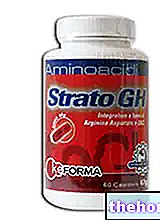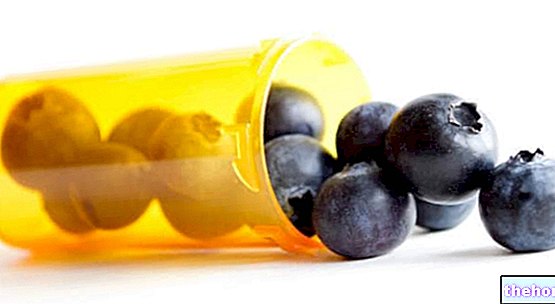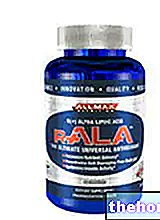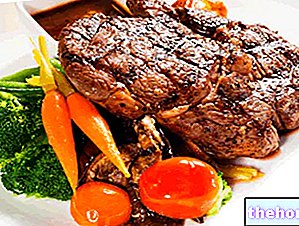Generality
Carnosine is a dipeptide formed by the union of two amino acids, called, respectively, histidine and Β-alanine; for this reason it is also known as Β-alanine-L-histidine.

For this reason, Carnosine can be found in nature in foods such as beef (150-450 mg per hectogram) and chicken (50-200 mg per hectogram), while it is practically absent in the vegetable kingdom.
However, the vegetarian diet is still very rich in antioxidants so, considering also the presence, in our body, of an enzyme capable of synthesizing it, a "possible food shortage should not worry vegan people too much.
Carnosine has been particularly successful in recent years by virtue of its antioxidant and buffering activity, which is valuable in some areas such as anti-aging medicine and sports dietetics.
Indications
Why is Carnosine used? What is it for?
Carnosine is classically attributed with antioxidant, buffering and anti-aging activities.
For these reasons, Carnosine-based supplements are classically used:
- As antiaging remedies;
- As neuroprotective agents;
- As antioxidants;
- As anti-inflammatory agents;
- As muscle buffer systems during moderate to high intensity performance.
By virtue of these activities, Carnosine is successfully used in the prevention of oxidative states such as cataracts, in anti-aging medicine and in sports.

Carnosine - Chemical Structure
In recent works, Carnosine would also prove to be a useful molecule with immunomodulatory activity.
Properties and Effectiveness
What benefit has Carnosine shown during the studies?
The large amount of literature relating to the clinical efficacy of Carnosine has allowed over time to adequately characterize the biological properties of this molecule.
anti-glycation and anti-aging activity
Carnosine helps prevent glycosylation, a process in which there is a non-enzymatic reaction of sugars with the amino acids that make up proteins.
AGEs (advanced glycosylation products) are the end result of this process. Their accumulation decreases renal and nerve function, also increasing the risk of mortality from cardiovascular disease and cancer.
According to some theories, AGEs are the basis of the natural aging process.
The formation of AGEs is facilitated by high levels of glycaemia and these products are the main culprits of the diseases associated with diabetes.
In 1999 Australian researchers confirmed the ability of carnosine to increase the longevity of human fibroblasts in vitro. Carnosine managed to increase the maximum number of cell divisions from 50 to more than 60. This parameter is one of the pillars of Haflick's theory of aging, which during his studies showed that the number of replications of fibroblasts belonging to various animal species it was proportional to the maximum life span of the animal itself.
Although its real properties have not yet been clarified, Carnosine has all the prerequisites to become the anti-aging supplement of the future.
Carnosine and antioxidant activity
During the studies, Carnosine proved to be an excellent antioxidant.
In addition to the direct scavenger activity against free radicals of oxygen and nitrogen, Carnosine would have proved effective in protecting cellular structures from the formation of non-functional adducts.
This mechanism would be the basis of the neuroprotective, and more generally cytoprotective, action of Carnosine.
Recent studies, conducted in vitro, have also shown the usefulness of Carnosine in reducing the oxidation levels of LDL, thus carrying out an important preventive action against atherosclerotic damage.
Part of the success of Carnosine in sports is also to be attributed to the antioxidant property, precious in protecting the muscle fibers from the damaging damage induced by reactive oxygen species.
Carnosine and buffer activity
During moderate-intensity exercise there is a muscle build-up of lactic acid and hydrogen ions, with a sharp lowering of the cytosolic pH.
The drop in muscle pH seems to be associated with a progressive decline in contractile capacity, with the inevitable reduction in performance.
Carnosine would carry out an impressive buffer activity, thus preserving the maintenance towards more neutral values of the cellular pH, and indirectly contributing to the improvement of performance.
Dosage and method of use
How to use Carnosine?
The doses of carnosine most used in studies are generally between 100 and 500 mg per day.
However, there are works in which Carnosine has also been taken at dosages higher than one gram, without however particularly significant advantages.
In sports, the activity of Carnosine could be supported by the simultaneous intake of other antioxidants, especially if taken in the immediate pre-workout phases.
Side effects
The use of Carnosine is generally safe and well tolerated.
However, side effects deriving from the prolonged administration of Carnosine over time are not known.
Contraindications
When should Carnosine not be used?
The use of Carnosine is contraindicated in case of known hypersensitivity to the active ingredient and in clinically relevant liver and kidney diseases.
Pharmacological interactions
What drugs or foods can modify the effect of Carnosine?
No noteworthy drug interactions are currently known.
Precautions for use
What do you need to know before taking Carnosine?
Given the absence of studies capable of characterizing the safety of Carnosine for pregnant women and nurses, it is advisable to avoid its use during pregnancy and the subsequent period of breastfeeding.
The use of Carnosine, in the presence of overt pathological states, should be supervised by the doctor.
















.jpg)











